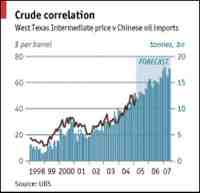It’s just what I wrote last month. All new energy is a long-term investment. Whether you’re drilling for oil and gas, trying to squeeze oil out of coal, building an ethanol plant, or trying to make a bundle on solar, wind, or geothermal power, you need both money and time for your plans to work.
Volatility kills time.
Let’s say that last month you had a great plan for solar power, based on a price of $130 per barrel of oil. You’re underwater now. But chances are you never got funded, because everyone knew that, while there was a chance oil might climb to $180/barrel, it might also fall to $120/barrel.
What energy investments need most is a stable price on which to base
long-term investments. They don’t need outright subsidies. They need to
know they can earn a profit if they can bring in their supplies at the
prices they have promised.
Again as I’ve said before, the answer is a floor price. It’s just what
the Republicans of a generation ago did to bring up corn supplies. The
purpose is the same, to assure supply a market.
There are risks to a floor price. Other countries may stay with the
market and, in time, get new supplies at a price below the floor price.
This, critics state, will give them an advantage. But you will have
created new supply. You will have created new technology. And you will
have created new companies whose expertise can be exported whenever the
market price rises above their cost of supply.
This last is critical. As energy investments scale, incremental costs go
down. Once the cost of drilling offshore is captured oil wells are cash
gushers. The same is true here, to a lesser extent. Once the cost of
your windmills or solar panels and your supply infrastructure is
captured, the cost for producing additional supplies of energy drops
dramatically. (You just need to maintain the infrastructure and, over time, upgrade it.) At that point your floor price is acting as a subsidy,
and while it’s then subject to political pressure for adjustments it
has served its purpose.
So understand that we have a two-step process here. We have to create
new supplies of energy, and we need to assure those supplies of a
market. This means not just getting rid of the yoke of oil, but the
yoke of current energy markets, in which supply and demand hang on a
knife edge and are subject to sudden, wild shifts.
It’s not the speculation in the market that is the problem. It is the
auction market itself. You can’t make long-term plans on a short-term
auction. Replace it with a floor price.












